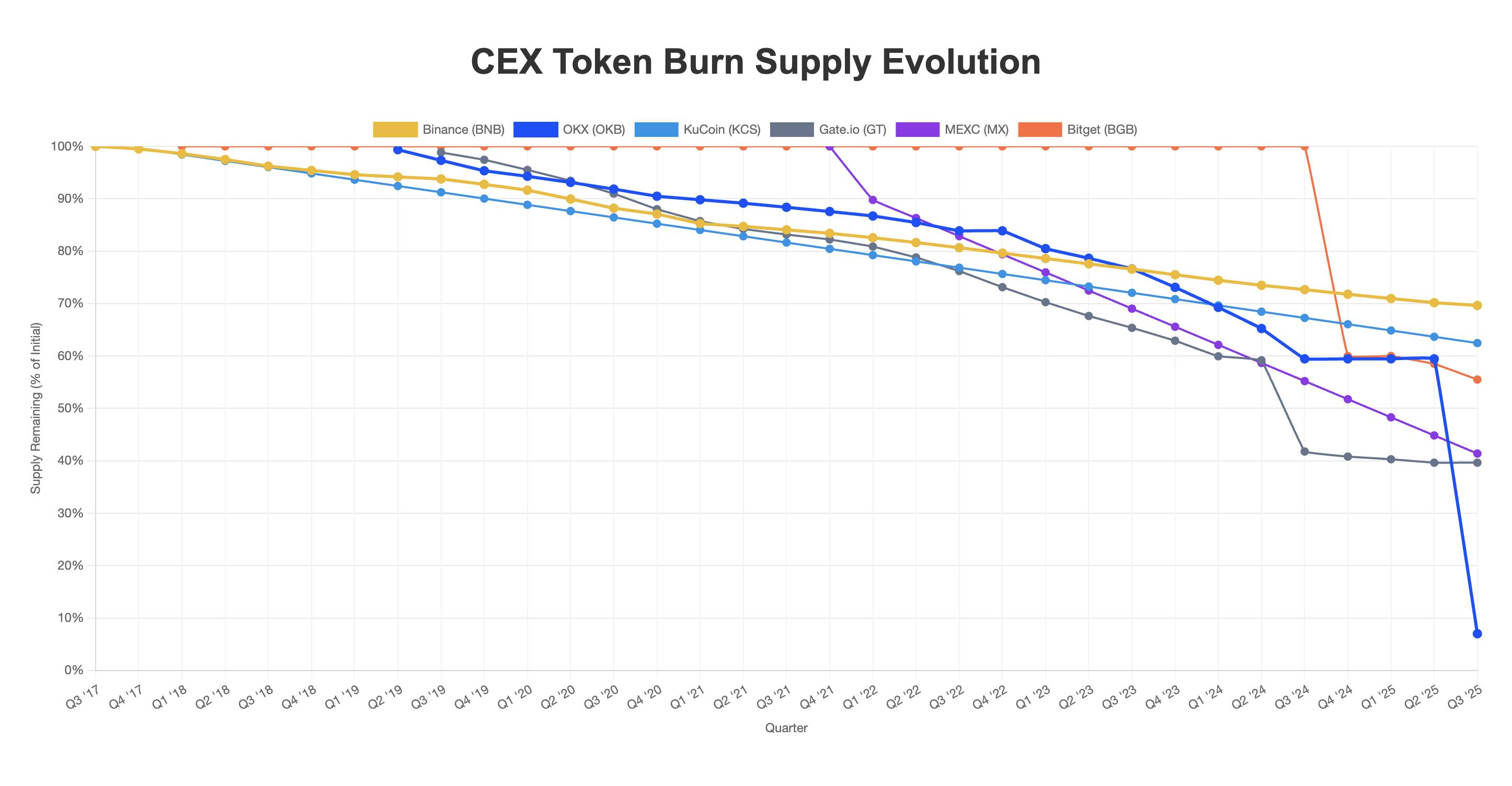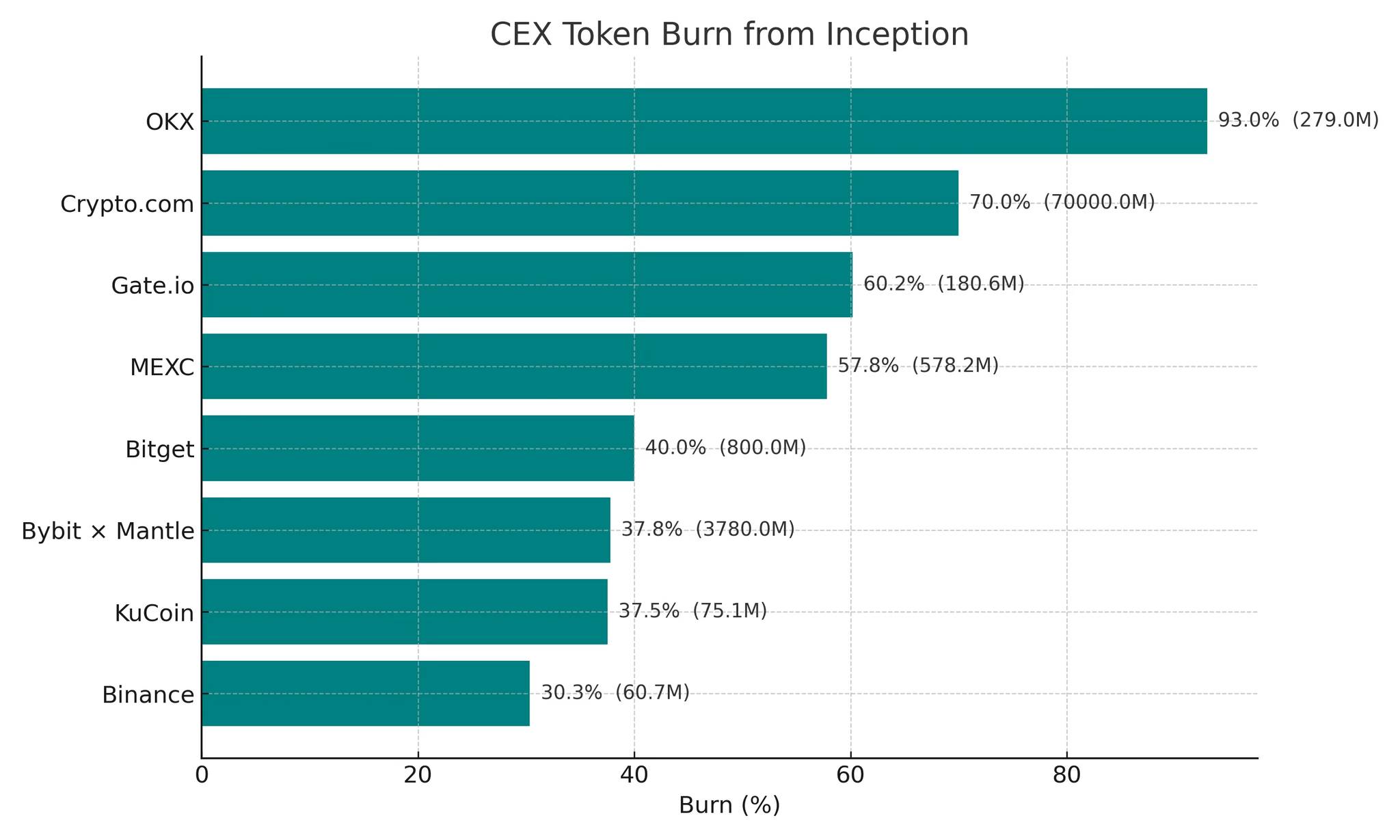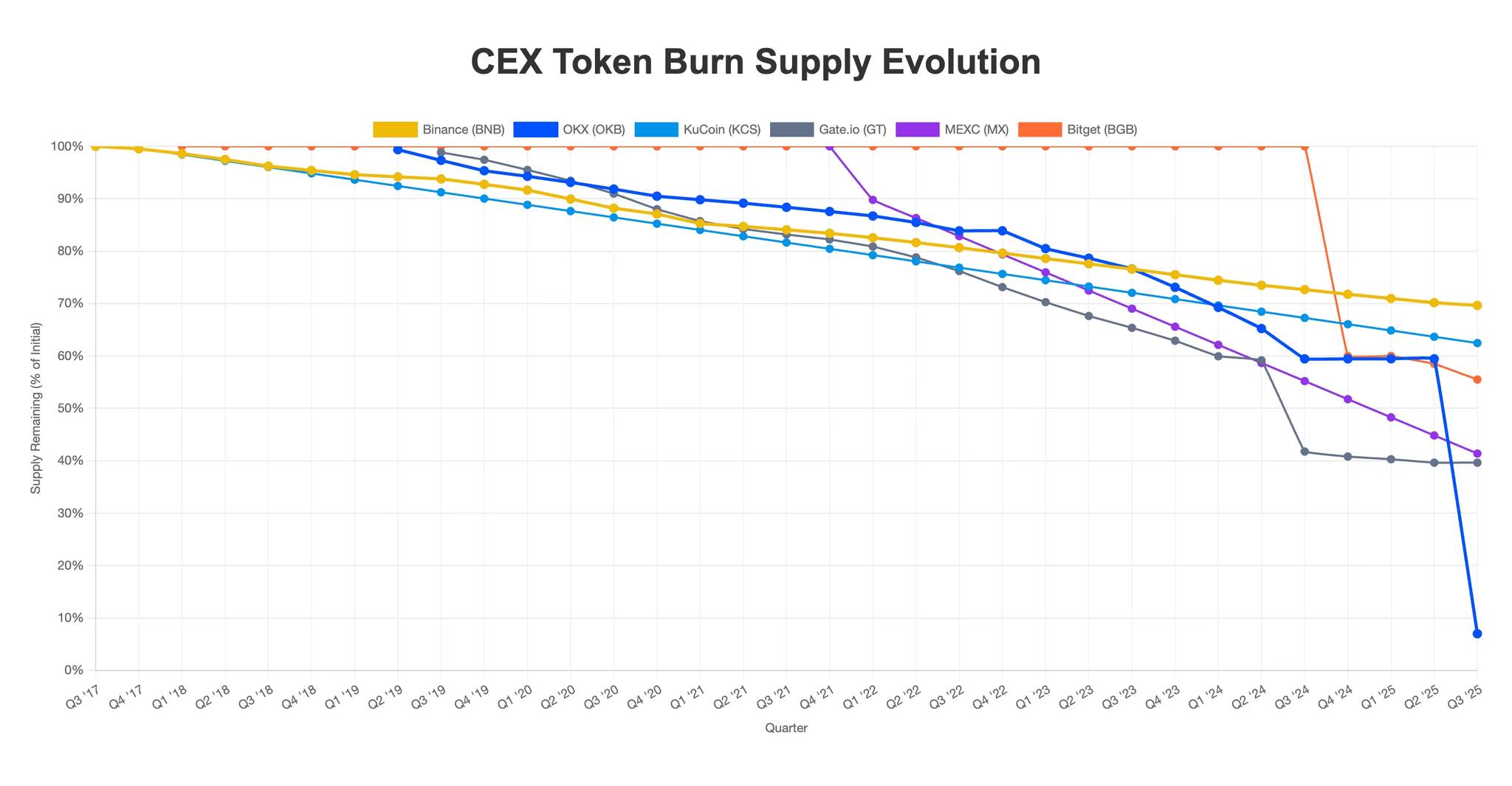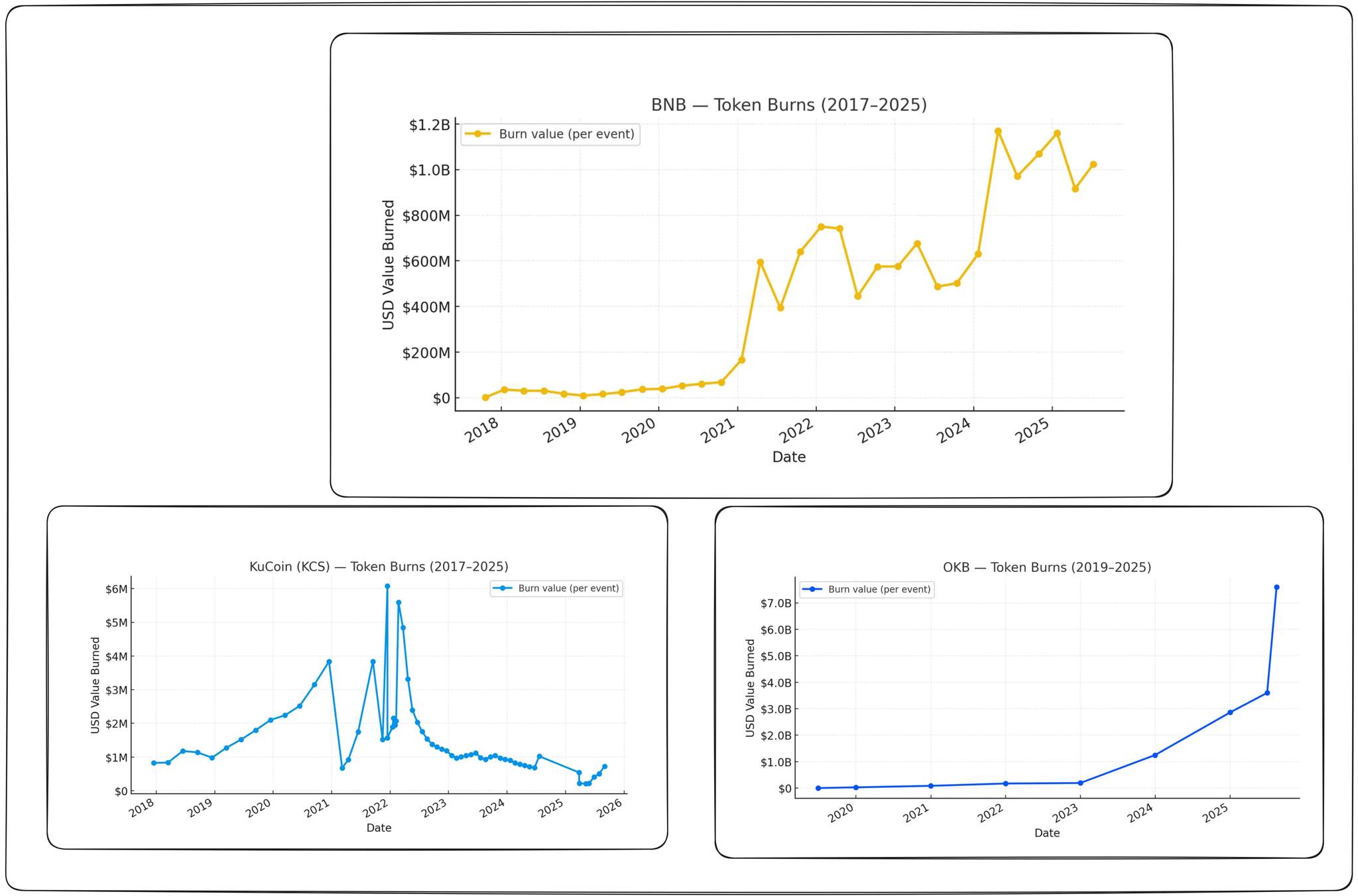True innovation does not lie in the destruction itself, but in the continuity and transparency of the destruction.
Author: Darshan Gandhi, Polaris Fund
Translation: Deep Tide TechFlow
In-depth exploration of centralized exchanges (CEX) and their token destruction: mechanisms, frequency, and other aspects.

The buyback and destruction by exchanges are not new.
These operations have been quietly ongoing for years, shaping the supply-demand landscape long before attracting mainstream attention. Almost every major centralized exchange (CEX), including Binance ($BNB), OKX ($OKB), Gate ($GT), KuCoin ($KCS), and MEXC ($MX), has implemented some form of destruction plan for over five years.

Today, the presentation of these token destructions has changed.
Hyperliquid ($HYPE) places token buybacks at the core of its token strategy, rather than hiding them in the fine print. It transforms the destruction mechanism from a background function into a prominent feature. More importantly, Hyperliquid operates the destruction as part of financial management, continuously and publicly, setting a new benchmark for transparency.
This positioning makes the destruction mechanism appear refreshing, even though established exchanges like Binance, OKX, Gate, KuCoin, and MEXC have been doing similar things for years. The difference is that established exchanges have never marketed it as aggressively or integrated the destruction mechanism so closely into financial operations (the reasons will be analyzed in detail later).
The destruction mechanism is essentially a means of value transfer, demonstrating the following points:
How exchanges link token supply to their business models
What levers drive scarcity (profits, formulas, or governance)
How credibility is built or lost over time
Additionally, the destruction mechanism acts as a tool for inflation control, stabilizing supply by offsetting token unlocks or issuances.
The question today is no longer whether destruction will occur, but whether the execution of destruction is sufficiently continuous and whether the model can provide transparency to token holders.
To clearly see this shift, here is a breakdown of how the dynamics of exchange token supply have changed.

Key Point: When analyzing exchange tokens, the destruction model is crucial. Designs based on profits, formula-driven, or governance control will have vastly different impacts on scarcity, predictability, and trust.
Destruction Models: The Operating Modes of Exchanges
Exchange destruction plans are mainly divided into three categories:
Profit or revenue-linked (Gate, KuCoin, MEXC): A fixed percentage of profits is used to buy and destroy tokens. The cadence is predictable and auditable.
Formula or fund-driven (Binance, OKX, Bitget): Supply reductions are determined by formulas or fund allocations. They are larger in scale but have a weaker correlation with business health.
Governance-driven (Bybit, HTX): The pace of destruction is determined by token holder voting. This model decentralizes control but introduces political and execution risks.

Destruction plans are also continuously evolving. For example, Binance transitioned from a profit-linked destruction mechanism to one based on price and block count, later adding the BEP-95 gas fee destruction mechanism. Binance once suddenly changed the destruction rate as proof of BNB's non-securitization. From a regulatory perspective, this depersonalized destruction reduces the risk of securities classification, but the constantly changing mechanism leaves the market feeling uncertain.
Additionally, other CEXs have updated their dynamics, such as:
KuCoin adjusting the destruction pace to monthly for transparency.
Gate maintaining a stable 20% profit distribution since 2019.
Due to the fixed maximum supply of tokens, destruction is not common. When it does occur, it is valuable because it can reduce circulating supply and accelerate the process of complete supply compression.
Key Point: The destruction model determines persistence. Profit-linked = stable and auditable. Formula-driven = scalable but opaque. Governance-driven = decentralized but harder to trust. Sudden model changes (e.g., Binance) can create structural risks, while increased transparency (e.g., KuCoin) builds trust.
Regulatory Perspective
Destruction models are not only about economics but also involve regulatory positioning.
In traditional stock markets, corporate buybacks have been controversial, with the U.S. Securities and Exchange Commission (SEC) questioning them on grounds of:
Market manipulation
Conflicts of interest
Weak information disclosure standards
Token destruction is equivalent to buybacks in cryptocurrency, but it lacks legal protection. This gap changes the way models are designed.
Profit-linked destruction looks most like a buyback. Since it directly ties token value to profits, it raises closer regulatory scrutiny.
Formula-driven destruction mechanisms (e.g., Binance's automatic destruction, OKX's supply cap) are easier to defend. They can be described as mechanical, unrelated to income, and less likely to trigger securities classification.
Governance-driven destruction increases political factors. Regulators may view community voting as insufficient to prevent manipulation.
Key Point: Destruction design is part of token economics and part of legal defense. Decoupling destruction from profits reduces regulatory risk but also lowers transparency for token holders.
Trends in Exchange Models
The following three model trends are particularly notable:
- Scale and Opaqueness
Binance has the largest destruction scale (about $1 billion per quarter), but the rules are constantly changing.
OKX eventually set a supply cap of 21 million after years of pacing.
**Key Point: Scale attracts attention, but changing rules and delayed cap settings weaken **transparency.
- Stable profit-linked cadence
Gate: Fixed 20% profit distribution since 2019, having destroyed about 60% of the supply.
MEXC: 40% profit distribution, having destroyed about 57%.
KuCoin: Changed to monthly destruction in 2022, but the scale of destruction shrinks with increased profitability (10% of profits).
Key Point: Profit-linked models are the easiest to predict. The less capital consumed, the worse the business health.
- New Entrants and Governance Risks
Bitget: Plans to destroy $5 billion by December 2024, currently destroying about 30 million tokens per quarter, aiming to destroy 95%.
Mantle: Destroyed 98.6% of BIT during migration; now relies on DAO.
Key Point: Marketing does help, but only verified cadence can enhance persistence.
Destruction Cadence, Scale, and Quality
The extent of supply reduction varies from about 30% for Binance to about 93% for OKX. However, the market prices not just the percentage but also the continuity of destruction scale and the predictability of cadence.
Gate, KuCoin, and MEXC: Stable profit-linked destruction → builds trust
Binance: Largest scale → obscured by constant formula adjustments
OKX: Enhanced confidence through a massive $7.6 billion destruction → supported by years of consistency
Bitget: $5 billion destruction → first event not yet verified, needs to observe subsequent developments
Crypto.com: 2025 revocation of 2021 destruction → leads to reduced trust
Note: The large-scale destruction in August 2025 coincided with a significant rise in OKB, indicating that one-time supply events can sometimes drive recent price movements.
**Key Point: Do not just track the number of destructions, but ask: Is the scale repeatable? Is the cadence linked to profits? Is governance stable? Focus on the dollar scale of quarterly/annual destruction. *Large* destruction = a credibility indicator, not a guarantee.

Our Overall View
Consistency is more important than scale: The market is more inclined to reward repeatability rather than merely creating headlines.
Profit-linked models are best: They tie token value to the health of the exchange and are easy to assess (transparent).
Large destructions are just markers: Without follow-up actions, they will gradually become superficial.
Currently, buybacks remain an important marketing cost.
Interestingly, centralized exchanges actually choose to reinvest profits into their own tokens rather than retaining earnings in cash or USDC. This practice concentrates treasury value in the tokens themselves while amplifying both gains and risks.
Finally, as we have attempted to articulate throughout this report, true innovation does not lie in the destruction itself, but in the continuity and transparency of the destruction. Hyperliquid has undoubtedly redefined destruction as a visible, cyclical financial management function. This effectively reshapes the expectations of the entire industry: today, merely having scarcity is not enough. Regular, clear, and economically consistent scarcity is the direction that all exchanges should truly value. This change may pose significant challenges for those CEXs that are slow to act.
免责声明:本文章仅代表作者个人观点,不代表本平台的立场和观点。本文章仅供信息分享,不构成对任何人的任何投资建议。用户与作者之间的任何争议,与本平台无关。如网页中刊载的文章或图片涉及侵权,请提供相关的权利证明和身份证明发送邮件到support@aicoin.com,本平台相关工作人员将会进行核查。



